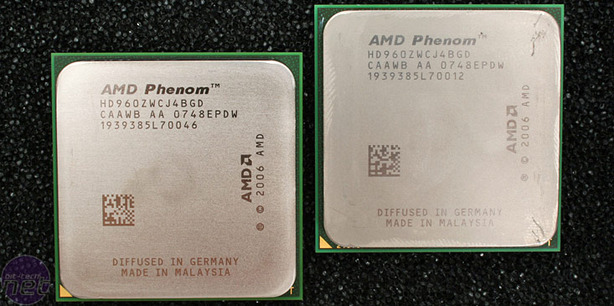AMD’s Phenom 9600 Black Edition
Manufacturer: AMDUK Price (as reviewed): £169.95 (inc. VAT)
US Price (as reviewed): $258.87 (excl. Tax)
Introduction
Our first look at the new AMD Phenom processors left us feeling a little muted. It wasn’t that it was bad, it just didn’t have the performance to keep up with Intel’s superior Core 2 CPUs. We felt that if it had more clock speed it would certainly be more competitive, and after hearing that the Phenom 9600 at 2.3GHz will also come as a multiplier-unlocked Black Edition, we just had to get our hands on one (or two).Both the standard Phenom 9600 and Phenom 9600 Black Edition will cost you roughly the same – between £150-to-£180, depending where you prefer to shop. The problem is, the Intel Core 2 Quad Q6600 is still undercutting this price as you can pick one up for £150-£160. In contrast, the Core 2 Quad Q6700, where Intel has no competition is over twice the price at £330.
Most people have bought Intel’s Core 2 Quad Q6600 with the intention of overclocking, but for those still wanting to support AMD, running a Phenom at 2.6, 2.7, 2.8... 3GHz is the only real attractive option and a Black Edition with its multiplier unlocked is an absolute must. As it stands, with the current B2 stepping we’ve not seen more than 210MHz CPU bus remain stable, but as the north bridge clock is now decoupled from the CPU HyperTransport clock, it means the memory is no longer tied to the CPU; dropping the HyperTransport speed will just simply drop the performance – it’s just not worth it.
Clearly AMD is literally running HT 3.0 with very little overhead. To get any significant CPU clock increase we need to jack up the multiplier instead.

Testing Platform
We used our usual CPU testing platform that we had previously used for the engineering sample CPUs: an Asus M3A32-MVP Deluxe WiFi-AP motherboard which features the new AMD 790FX chipset, an Nvidia GeForce 8800 Ultra graphics card, as well as a Zerotherm Nirvana NV120 CPU cooler to keep the CPU cool and a pair of OCZ DDR2 PC2-9200 FlexXLC Edition memory modules running at 1,066MHz 5-5-5-15 to keep the system well fed with memory bandwidth.The Phenom 9600 has a worst-case TDP of 95W which is quite high but isn’t that bad, and during testing we found the Zerotherm Nirvana NV120 with its fan at full speed kept the overvolted CPU under 50˚C when loaded. While the fan is considerably loud, we wanted to obtain the maximum overclock possible using air cooling. The Phenom 9600 has a stock clock speed of 2.3GHz with an 11.5x multiplier and even though the Asus motherboard allowed adjustment of the north bridge frequency (stock clocked at 1.8GHz) we left it as is.
The north bridge and L3 cache frequency are directly linked, so keeping these out of the equation should allow for better CPU core overclocking. In addition, we also left the TLB on because the performance drop from turning it off is likely be more than what overclocking is worth, unless we hit some really high frequencies. In addition, the TLB errata is effectively a non-issue as it only rears its head in very niche scenarios.
As you no doubt know, overclocking is not a warrantied exercise and running your CPU outside of its rated specification can cause permanent damage. In addition, no overclock is ever guaranteed as every system configuration—even different batches of the same component—can react differently to overclocking.
We tried to use AMD’s OverDrive utility – the latest version at the time of our testing was 2.0.14 beta, which we found to be actually quite unstable; it regularly hard locked our system, and also misreported voltage readouts. While the software has lots of features we wanted to use, we still preferred to overclock “old school style” from the BIOS because it was simply more reliable.

MSI MPG Velox 100R Chassis Review
October 14 2021 | 15:04









Want to comment? Please log in.